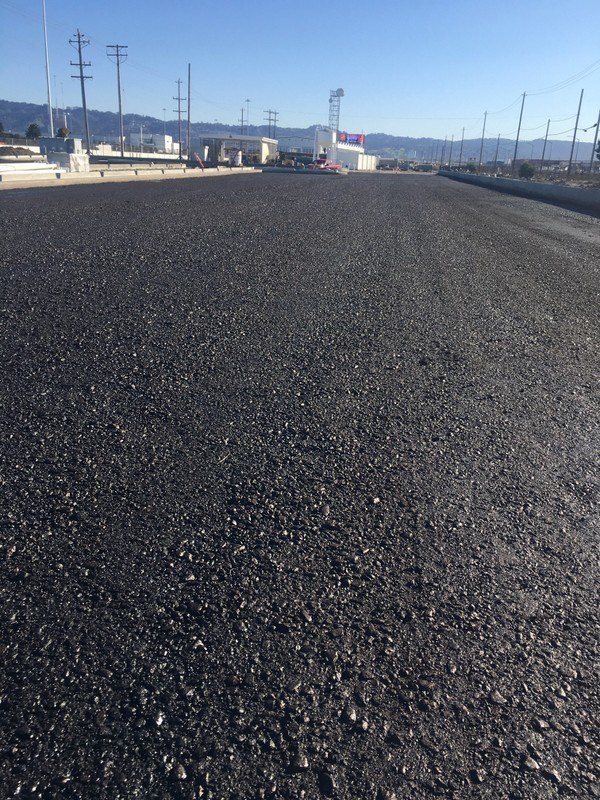
Prime Coats can be very beneficial to the construction of bituminous pavements. A prime can be defined as the application of a binder material that is applied to the surface of a compacted granular base, as a preliminary treatment before the subsequent application of surface treatment.
For bituminous pavement construction, prime coats are normally applied to:
- Strengthen the surface of a granular base by binding the particles of aggregate together;
- Seal the surface of the compacted base making it water-resistant and thereby reducing the migration of moisture in and out of the material;
- Inhibit the absorption of the initial bituminous surface layer;
- Provide the base with temporary protection against the detrimental effects of weather and light traffic until the pavement layer can be constructed; and
- Promote adhesion between the granular base and the bituminous layer.
It is important that the applied prime penetrate into the compacted granular base adequately and cure quickly. Some prime coats may need to be mixed in to enhance their “penetration” however they are mostly applied topically.
Prime coats may not always be necessary, however, there have been numerous failures due to the omission of a prime coat. Most definitely, the application of a prime coat can cost-effectively reduce the risk of a premature failure resulting from possible imperfections that may occur in the base, which will be very costly to repair.
Prime coats differ from a tack coat by being applied specifically on top of a prepared granular base, to protect the surface, before the first layer of paving is applied. Whereas a tack coat is applied afterward, later in the project, to form an adhesive interface between the asphalt layers.
The binders that are used as prime coats are typically cutback asphalts (e.g., MC-30), emulsified asphalt specialty products (e.g., AEP, EAP, and PCE), and slow set asphalt emulsions (e.g. SS-1). With all these choices there still may be challenges. For example, when using cutbacks, road engineers may be concerned with safety due to their flammability, the chance of releasing volatile organic compounds (VOCs), and the possibility of softening the bituminous layer that is applied over the prime due to the inhibition of the VOCs from escaping and remaining behind sequestered at the interface of the paving layer. Also, cutbacks are very slow to return to traffic or to pave immediately after application, sometimes days to weeks. Likewise, specialized emulsified asphalt primes may cure relatively quickly, however since these emulsions can also contain organic solvents they still may release VOCs into the air. Whereas traditional slow-setting asphalt emulsions can set relatively fast, but they penetrate minimally…” plating” out on the surface and therefore may need to be mixed or “cut-in” to achieve suitable penetration. Despite these issues, it is important to know that there is a viable alternative that will minimize these challenges. This alternative is a product known as Earthbind® Prime.
Earthbind® Prime is a quality, versatile specialized modified asphalt penetrating prime coat. Earthbind® Prime was developed to meet the need for a quality and cost-effective prime coat that works well penetrating, stabilizing, and controlling dust on granular road material. In addition, Earthbind® Prime is an environmentally-friendly product that can be safely stored and easily applied. Earthbind® Prime is sold and transported in concentrate form and is diluted with water prior to application.
Earthbind® Prime works by penetrating into the granular surface and binding soil/aggregate particles together, thereby strengthening the treated material. Earthbind ®Prime is exceptional in penetrating aggregate/soil matrix, adding water resistance, and adhesion to any new surface treatment applied to it. Earthbind® Prime works especially well on surfaces of granular bases with excessive fines. In addition, Earthbind® will not re-emulsify due to rainwater after curing.
As a penetrating prime coat Earthbind® Prime:
- Efficiently binds surface fines together and promotes bonding to any bituminous surface treatment;
- Protects the underlying road base layers from moisture by providing a waterproofing layer;
- Effectively penetrates the many types of compacted granular road bases;
- Will not soften of negatively impact the bituminous paving layer;
- Decreases the time delays during construction by paving very soon after application;
- Simple application using a water truck or pressurized distributor truck; and
- Easy clean-up – washes off equipment and vehicles before curing.
All components of Earthbind® Prime are considered:
- Free of hazardous solvents
- Non-flammable
- Non-corrosive to metals
- Not considered to be harmful to aquatic and mammal life
- Not considered to be carcinogenic
The general application rate is 0.60 gals/yd² of a 1-part Earthbind® Prime and 5-parts water. Material type and design may change the application rate but can be easily pre-determined in the field.
For more information on how Earthbind® Prime can work for your project, please contact an EnviRoad sales engineer at 503-279-2600.
Note: Blue Line is a distributor and applier of Earthbind® Prime.
References
Cross, S.A., and P.P. Shrestha, “Guidelines for Using Prime and Tack Coats,” Report FHWA-CFL/TD-02-002, Central Federal Lands Highway Division, Federal Highway Administration, Lakewood, Colorado, 2005.
Freeman, Thomas J., et al. “Effective Prime Coats for Compacted Surfaces,” Report FHWA/TX-10/0-5635-1, Texas Transportation Institute, Texas A&M University System, February 2010.
Mantilla, C., and J.W. Button, “Prime Coat Methods and Materials to Replace Cutback Asphalt,” Report 1334-1F, Texas Transportation Institute, Texas A&M University, College Station, Texas, 1994.
NITRR, Technical Recommendations for Highways (TRH 1), National Institute for Transport and Road Research, Council for Scientific and Industrial Research, Pretoria, South Africa, 1986. PCA,
Senadheera, S., and M. Vignarajah, “Design and Construction Guide for Surface Treatments over Base Courses,” Research Report 0-5169-P2, Center for Multidisciplinary Research in Transportation (TechMRT), Texas Tech University, Lubbock, Texas, 2007.
TxDOT, Standard Specifications for Construction and Maintenance of Highways, Streets, and Bridges, Texas Department of Transportation, Austin, Texas, 2004.


